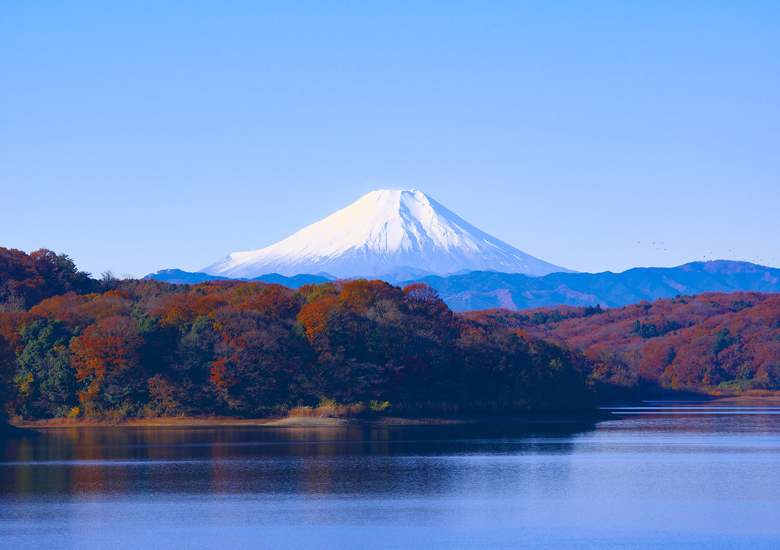Mount Fuji , located on Honshu Island, is the highest mountain in Japan at 3,776.24 m (12,389 ft).
It is an active stratovolcano that last erupted in 1707–1708. Mount Fuji lies about 100 kilometers (60 mi) south-west of Tokyo, and can be seen from there on a clear day. Mount Fuji’s exceptionally symmetrical cone, which is snow-capped for about 5 months a year, is a well-known symbol of Japan and it is frequently depicted in art and photographs, as well as visited by sightseers and climbers.
Mount Fuji is one of Japan’s “Three Holy Mountains” along with Mount Tate and Mount Haku. It is also a Special Place of Scenic Beauty and one of Japan’s Historic Sites. It was added to the World Heritage List as a Cultural Site on June 22, 2013. According to UNESCO, Mount Fuji has “inspired artists and poets and been the object of pilgrimage for centuries”. UNESCO recognizes 25 sites of cultural interest within the Mt. Fuji locality. These 25 locations include the mountain and the shrine, Fujisan Hongu Sengen Taisha, as well as the Taisekiji Head Temple founded in 1290, later immortalized by Japanese ukiyo-e artist Hokusai.
History : Mount Fuji is an attractive volcanic cone and a frequent subject of Japanese art especially after 1600, when Edo (now Tokyo) became the actual capital and people saw the mountain while traveling on the Tokaido road. The mountain is mentioned in Japanese literature throughout the ages and is the subject of many poems. One of the modern artists who depicted Fuji in almost all her works was Tamako Kataoka.
It is thought that the first recorded ascent was in 663 by an anonymous monk. The summit has been thought of as sacred since ancient times and was forbidden to women until the Meiji Era in the late 1860s. Ancient samurai used the base of the mountain as a remote training area, near the present-day town of Gotemba. The shogun Minamoto no Yoritomo held yabusame in the area in the early Kamakura period.
Founded by Nikko Shonin in 1290 on the lower slopes of Mount Fuji in Shizuoka Prefecture is the Taiseki-ji temple complex, the central base headquarters of Nichiren Shoshu Buddhism, which is visited by thousands of westerners and Asian believers from neighbouring countries each year who go on varying Tozan pilgrimages.
The first ascent by a foreigner was by Sir Rutherford Alcock in September 1868, from the foot of the mountain to the top in eight hours and three hours for the descent.:427 Alcock’s brief narrative in The Capital of the Tycoon was the first widely disseminated description of the mountain in the West.:421–7 Lady Fanny Parkes, the wife of British ambassador Sir Harry Parkes, was the first non-Japanese woman to ascend Mount Fuji in 1869. Photographer Felix Beato climbed Mount Fuji in the same year.
Today, Mount Fuji is an international destination for tourism and mountain climbing. In the early 20th century, populist educator Frederick Starr’s Chautauqua lectures about his several ascents of Mount Fuji—1913, 1919, and 1923—were widely known in America. A well-known Japanese saying suggests that a wise person will climb Mt. Fuji once in their lifetime, but only a fool would climb it twice. It remains a popular symbol in Japanese culture, including making numerous movie appearances, inspiring the Infiniti logo, and even appearing in medicine with the Mount Fuji sign.
Geography : Mount Fuji is a distinctive feature of the geography of Japan. It stands 3,776.24 m (12,389 ft) high and is located near the Pacific coast of central Honshu, just west of Tokyo. It straddles the boundary of Shizuoka and Yamanashi Prefectures. Four small cities surround it: Gotemba to the east, Fujiyoshida to the north, Fujinomiya to the southwest, and Fuji to the south. It is also surrounded by five lakes: Lake Kawaguchi, Lake Yamanaka, Lake Sai, Lake Motosu and Lake Shoji. They, and nearby Lake Ashi, provide views of the mountain.
The mountain is part of the Fuji-Hakone-Izu National Park. It can be seen more distantly from Yokohama, Tokyo, and sometimes as far as Chiba, Saitama, Tochigi, Ibaraki and Lake Hamana when the sky is clear. Particularly in the winter it can be seen from the Shinkansen until it reaches Utsunomiya station. It has also been photographed from space during a space shuttle mission.

